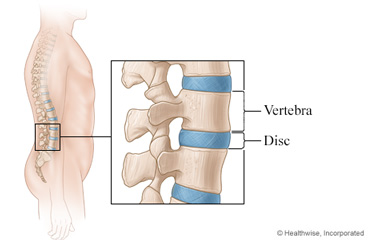
What is degenerative disc disease?
Degenerative disc disease isn't really a disease. It's a term used to describe the normal changes in your spinal discs as you age. Spinal discs are small, spongy discs that separate the bones (vertebrae) that make up the spine. The discs act as shock absorbers for the spine. They let your spine flex, bend, and twist.
Degenerative disc disease can take place in one or more places along the spine. It most often occurs in the discs in the lower back and the neck.
The changes in the discs can cause back and neck pain. They can also lead to osteoarthritis, a herniated disc, or spinal stenosis.
What causes it?
As we age, our spinal discs break down, or degenerate. This breakdown causes the symptoms of degenerative disc disease in some people.
When the discs break down, they can lose fluid and dry out, and their outer layers can have tiny cracks or tears. This leads to less padding and less space between the bones in the spine. The body reacts to this by making bony growths on the spine called bone spurs. These spurs can press on the spinal nerve roots or spinal cord. This can cause pain and can affect how well the nerves work.
These changes in the discs are more likely to occur if you smoke, do heavy physical work (such as repeated heavy lifting), or are very overweight. A sudden injury may also cause changes to occur.
What are the symptoms?
Many people with degenerative disc disease have no pain. But others have severe pain or other symptoms that limit their activities. Some of the most common symptoms are:
- Pain in the back or neck. Where the pain occurs depends on which discs are affected.
- Pain that gets worse when you move, such as when you bend over, reach up, or twist.
- Pain that may occur in the rear end (buttocks), arm, or leg if a nerve is pinched.
- Numbness or tingling in your arm or leg.
The pain may start after a major injury (such as from a car accident), a minor injury (such as a fall from a low height), or a normal motion (such as bending over to pick something up). It may also start gradually for no known reason and get worse over time.
How is it diagnosed?
A doctor can often diagnose degenerative disc disease while doing a physical exam. If your exam shows no signs of a serious condition, imaging tests (such as an X-ray) aren't likely to help your doctor find the cause of your symptoms.
Sometimes degenerative disc disease is found when an X-ray is taken for another reason, such as an injury or other health problem. But even if the doctor finds degenerative disc disease, that doesn't always mean that you will have symptoms.
How is degenerative disc disease treated?
Self-care may be all you need to relieve pain caused by disc changes. This may include using ice or heat and taking over-the-counter medicines.
If you develop health problems such as osteoarthritis, a herniated disc, or spinal stenosis, you may need other treatments. These include physical therapy and exercises for strengthening and stretching the back. Your doctor may prescribe medicines. In some cases, surgery may be recommended. It usually involves removing the damaged disc. In some cases, the bone is then permanently joined (fused) to protect the spinal cord. In rare cases, an artificial disc may be used to replace the disc that is removed.
How can you care for yourself?
Here are some things you can do to help manage pain from degenerative disc disease.
- Use ice or heat (whichever feels better) on the affected area.
- Put ice or a cold pack on the area for 10 to 20 minutes at a time. Put a thin cloth between the ice and your skin.
- Put a warm water bottle, a heating pad set on low, or a warm cloth on your back. Put a thin cloth between the heating pad and your skin. Do not go to sleep with a heating pad on your skin.
- Ask your doctor if you can take an over-the-counter pain medicine.
These include acetaminophen (such as Tylenol) and nonsteroidal anti-inflammatory drugs, such as ibuprofen or naproxen. Be safe with medicines. Read and follow all instructions on the label.
- Get some exercise every day.
Exercise is one of the best ways to help your back feel better and stay better. It's best to start each exercise slowly. You may notice a little soreness, and that's okay. But if an exercise makes your pain worse, stop doing it. Here are things you can try:
- Walking. It's the simplest and maybe the best activity for your back. It gets your blood moving and helps your muscles stay strong.
- Exercises that gently stretch and strengthen your stomach, back, and leg muscles. The stronger those muscles are, the better they're able to protect your back.
Follow-up care is a key part of your treatment and safety. Be sure to make and go to all appointments, and call your doctor if you are having problems. It's also a good idea to know your test results and keep a list of the medicines you take.
Where can you learn more?
Go to http://www.healthwise.net/patientEd
Enter U793 in the search box to learn more about "Learning About Degenerative Disc Disease".
Current as of: July 31, 2024
Author: Ignite Healthwise, LLC Staff
Clinical Review Board
All Ignite Healthwise, LLC education is reviewed by a team that includes physicians, nurses, advanced practitioners, registered dieticians, and other healthcare professionals.

